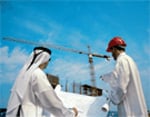OUTLOOK: Building Wonderland
The United Arab Emirates and the other Gulf States are investing gains from oil revenue in development and construction projects that amaze the world in terms of size, scope and investment.
DATE 2023-11-28 AUTHOR Birgitta Lundblad Coming to Dubai, the second largest (in terms of GDP) of the seven emirates that form the United Arab Emirates (UAE), is like entering one huge building site. There are buildings and development projects in different stages of construction everywhere, one more spectacular and luxurious than the other. They all signal two things; that this is an area of massive expansion and that there are enough funds to work wonders and provide the best the world has to offer.
Coming to Dubai, the second largest (in terms of GDP) of the seven emirates that form the United Arab Emirates (UAE), is like entering one huge building site. There are buildings and development projects in different stages of construction everywhere, one more spectacular and luxurious than the other. They all signal two things; that this is an area of massive expansion and that there are enough funds to work wonders and provide the best the world has to offer.
It is not surprising that Dubai is where you find the world’s only seven-star hotel, the Burj al Arab. And the breathtaking housing project on the Palm, built on reclaimed land at sea, forming an enormous palm tree visible from the air. And the on-going construction of the tower of the Burj Dubai Tower, expected to be over 700 metres high and the tallest man-made structure ever created.
Development in Dubai has exploded during the last few years and the emirate is buzzing with activity. The Government projects a doubling of the current population to 3.5 million by 2010. Dubai has no personal, corporate or sales taxes and foreign direct investment has expanded strongly. Many multinational companies see Dubai as the obvious choice for establishing operations in the region.
USD 275 billion investments
Revenues from high oil prices have resulted in a high availability of capital in the Gulf States as a whole and governments are diversifying their economies and making large investments within areas that can reduce their dependence on oil revenues. The tourism industry as well as the real estate and retail sectors are such areas.
Changes to laws allowing foreigners to own property in the region is one of the reasons for the unrivalled boom of the construction industry. The Gulf States are expected to invest more than USD 275 billion over the next 5 years. The UAE, seen as the business hub of the region and the gateway between Europe and Asia, account for 60 % of the projects under construction today.
Cooling – a vital necessity
Efficient cooling and air conditioning is a must in the sub-tropical climate in the Gulf States and all building schemes require well-functioning air-con systems to provide best possible comfort. More than 2.5 megatons of refrigeration will be needed for the projects announced or currently under way with completion within the next 5–8 years.
Since air conditioning accounts for up to 70% of the energy consumed in the region, utilizing systems that consume as little energy as possible is a matter of priority. This is why district cooling, which can save up to 50% of the energy compared to other systems, is rapidly gaining ground.
Air-con solutions adapted for the region’s needs
Alfa Laval’s solutions for district cooling, refrigeration and air conditioning of high buildings have a prominent position in the UAE and the other Gulf States. These solutions are supplied to district cooling providers or private property developers and serve a large number of prestigious projects.
In district cooling a single, central source is used for several buildings. Alfa Laval supplies plate heat exchangers for the sub-station in each building which are used to chill the water in the building’s air-conditioning system. In addition to large energy savings, district cooling results in significant savings both in capital and running costs and eliminates any vibrations and noise in the buildings. It is also a space-saving solution of great importance in these buildings where space is extremely limited and comes at a premium.
Alfa Laval’s highly efficient solution for cooling tall buildings is used extensively in this region, where very high buildings dominate the skylines. Plate heat exchangers are used as pressure interceptors to protect equipment such as chillers and air condition units against excessive pressure. Depending on the height of the building, there may be many plate heat exchangers acting as pressure breakers. The solution is extremely compact and needs minimum maintenance.
